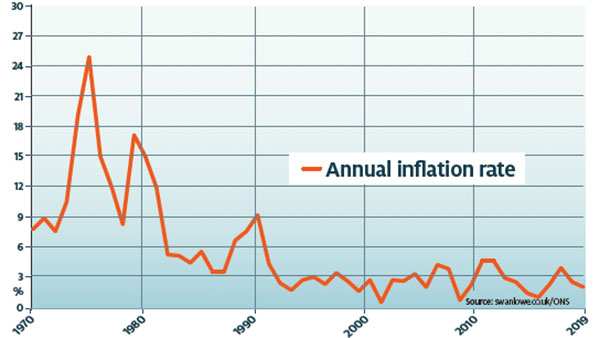Why the next decade will be nothing like the past four for private investors
With the yield from government bonds gone, investors with a 60/40 equity/bond portfolio will need to mak…
24th July 2020 12:10
by Andrew Pitts from interactive investor
With the yield from government bonds gone, investors with a 60/40 equity/bond portfolio will need to make some changes to secure the returns they are used to.

It was difficult to decide what to focus on in this valedictory column for Money Observer. In the end, I opted not to look back on how (I hope) we’ve helped our readers in the past 40-plus years to make well-informed and profitable financial planning and investment decisions. That might have been appropriate were Money Observer attempting to influence and impress a new cohort of readers, but that is, sadly, not the case, as the August 2020 issue is to be the last.
That is not to say the past cannot help inform us about the future. The technological advances of the past decade, together with the increasing influence of central banks and government policy on financial markets since the great financial crisis and this year’s pandemic, might encourage investors to think that ‘this time it’s different’ when they assess the outlook for equities. As the legendary investor Sir John Templeton once said, however, those are the four most expensive words in investing.
The most fascinating aspects of this year’s market ructions (to date) were not just the incredibly swift and steep decline of government bonds and equities in February and March, but the equally swift climb back up, particularly in the US, and especially among technology and healthcare stocks. That rally was initially driven by the massive injection of liquidity and support from central banks and governments shaking off the shackles of fiscal rectitude the world over.
What is not different this time, just as during the dotcom bubble 20 years ago, is the cast of characters that have continued to drive the rally in US stock prices ever higher: a herd of day-trading retail investors who stampede into stocks often picked on a whim by share tipsters with avid online followers. Most of them trade commission-free at US brokers such as Robinhood. Fingers will, inevitably, get burned.
-Will the Covid-19 crisis and QE trigger the return of inflation?
In search of a sensible balance
More widely, stocks have climbed the wall of worry because of ‘Tina’ – or ‘there is no alternative’. That is because cash and government bonds now yield next to nothing, courtesy of 11 years of quantitative easing (QE) – an estimated $14 trillion (£11 trillion) of government and investment-grade bonds now have negative yields, so that investors nominally lose money if they hold the debt until it matures.
It means there are few places left to invest for a decent return except in the riskier asset classes of equities, speculative corporate bonds, commodities and alternative assets. Among defensive equities that once provided reliable income streams, many of these companies are now seeking to rebuild battered balance sheets and introduce cash buffers in the wake of the coronavirus shock rather than pay dividends.
The reduction in yield from government bonds is bad news for investors who were once well-served by having a diversified portfolio. Before QE, investors could build a classic 60/40 equity/bond portfolio that provided some insurance: when equities slipped, the bond component could take the strain. Conversely, when equities were strong, the bond component would still pay an annual income to compensate for the lower returns it offered.
Over the past 10 years, a 60/40 portfolio has worked spectacularly well, because both bonds and equities have risen in value. Indeed, analysis from investment bank Goldman Sachs showed that a US 60/40 portfolio in the decade to 2020 produced its highest risk-adjusted returns in more than a century.
But what has been masked is the fact that the diversification benefits have steadily been eroded by the loss of income from the bonds. For example, the highly popular Vanguard LifeStrategy 60% Equity fund lost 12.4% in the first three months of this year.
Balanced investors therefore have to weigh up whether the premium for the bond insurance policy is still worth paying for the benefits that diversification used to bring. That is now highly questionable. As yields have collapsed to near-zero, the capital gains bonds have provided over the decade have likely run their course. That latter point is pertinent because both the US Federal Reserve and the Bank of England have stated that they do not want bond yields to turn negative.
However, there is not much headroom here: in the US the 10-year government bond yield is 0.6% and in the UK it is 0.16%. In the eurozone, investors are losing 0.44% a year for holding 10-year bonds to maturity.
Meanwhile, with the yield from government bonds gone, balanced investors need to have higher portfolio weightings to far more risky areas if they are to generate the level of returns they have become accustomed to, but commensurately, they must accept the potential for larger losses.
50 years of UK inflation*

*As measured by Retail Price Index (not recognised by the ONS as an official statistic since 2010)
The lurking danger
Whether you buy into the ‘Tina’ argument for equities or still believe that the classic 60/40 portfolio continues to have its place, the biggest risk to profits from both routes has been underestimated.
This danger has only fleetingly appeared on investors’ radar over the past 40 years or so, and it is probably the last thing on most investors’ minds right now. The global economy is going through a severe contraction, jobs are being lost hand-over-fist, real wages have not been rising for many years, and all point to a deflationary environment or at best a continuation of the disinflationary trend that has ruled since the early 1980s.
But some smart investors see an inflationary surge as the inevitable outcome of the past decade’s debt-fuelled profligacy followed by the release of ‘helicopter money’ that was required as a response to the pandemic. The last time we saw inflation above 5% was nearly three decades ago – in 1992 – so it will come as a shock to anyone under the age of 50.
What could trigger a resurgence in inflationary expectations and what can investors buy in the way of insurance policies?
Even before the pandemic struck and a fresh wave of QE and government spending was unleashed, governments had started to loosen the purse strings. In the UK, austerity had become a dirty world before the re-election of the Conservative government under Boris Johnson, who promised a spending spree. In the US, Donald Trump’s tax cuts have seen the fiscal deficit balloon; the coronavirus response means the budget deficit has hit $3 trillion in the year to June.
Inflation stations
Peter Spiller, co-manager of wealth preservation-minded Capital Gearing Trust and the CG Real Return fund, is in no doubt about what comes next. He says: “With the dramatic policy support, overall [economic] activity might with luck return to 2019 levels by 2022. But austerity will not follow; there is no political appetite for it and the debt burdens of governments and companies would be insupportable without powerfully growing nominal GDP. Inflation will permit prolonged financial repression to bring balance sheets back into equilibrium.”
Capital Gearing explicitly positions its portfolio to beat inflation by preserving investors’ real wealth, and to provide an absolute total return – goals it has rarely failed to achieve.
Teun Draasima and Ben Funnell, portfolio managers at Man Group, argue that investors should ignore the short-term deflationary signals and get ready for the inflationary shock they expect before it’s too late to cushion against it. They point to the classic inflation hedges of commodities – particularly gold – index-linked securities and floating-rate bonds.
In terms of the insurance element for the old traditional 60/40 balanced portfolio, these assets should also help fill the gap left by erstwhile income-producing government bonds. Balanced portfolio managers themselves may also need to consider investing in expensive protection products such as index put options to reduce risks.
Another good reason to consider the latter is that Draasima and Funnell point out that almost all asset classes – including equities – have seen real returns turn negative when inflation exceeds 4%.
The deflationary mega-trend has persevered throughout most of Money Observer’s 41 years. As we head off into the sunset, an inflationary dawn will follow, but when it will break is not yet known. In that sense, the next decade will be very different from the past four. I think Sir John Templeton would agree.
The author was editor of Money Observer from 1998 to 2015.
This article was originally published in our sister magazine Money Observer, which ceased publication in August 2020.
These articles are provided for information purposes only. Occasionally, an opinion about whether to buy or sell a specific investment may be provided by third parties. The content is not intended to be a personal recommendation to buy or sell any financial instrument or product, or to adopt any investment strategy as it is not provided based on an assessment of your investing knowledge and experience, your financial situation or your investment objectives. The value of your investments, and the income derived from them, may go down as well as up. You may not get back all the money that you invest. The investments referred to in this article may not be suitable for all investors, and if in doubt, an investor should seek advice from a qualified investment adviser.
Full performance can be found on the company or index summary page on the interactive investor website. Simply click on the company's or index name highlighted in the article.